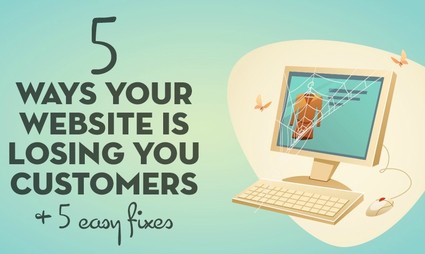 If you’re running your own business, your website should be the hub of all of your marketing efforts. It should be pulling prospects in, and keeping them there long enough to convince them to become a customer, growing your business in the process.
If you’re running your own business, your website should be the hub of all of your marketing efforts. It should be pulling prospects in, and keeping them there long enough to convince them to become a customer, growing your business in the process.
Unfortunately, for many businesses, this just isn’t the case. I can’t tell you how many web design clients I’ve had over the years who have no real goal defined for their website. I’ll ask why they want a website or a redesign, and they’ll say something like:
“We just want something that looks cool, that people can check out online.”
Face-palm!
Come on, you can do better than that. Your website has the potential actually to get you more leads, customers, and sales, so settling for a digital “brochure” is a huge missed opportunity.
If this sounds like what you’ve been doing with your website, fear not. I am going to walk you through five of the most common ways business websites miss the mark with potential customers, as well as simple advice that will get you started in fixing each problem.
1. No Call-to-Action.
If you’ve designed your website to be mostly informational, chances are you never defined your call-to-action (CTA.) A CTA is simply asking your site visitors to complete some task that you can define as a goal.
For instance, you might want them to pick up the phone and call you. In that case, you might have a very large text box that says “Call Us Today”, followed by your phone number. The simple step of telling them to call you has been shown to increase calls drastically, as opposed to simply displaying your phone number.
Or maybe you want to make a sale on your website. If that’s the case, don’t be shy about it. Make the “Buy Now” button large, and make sure it stands out against its surroundings for maximum click-throughs.
2. You’ve Made it All About You
When most businesses write the copy that goes to their website, they think their customers want to know the story of the business. They assume that carries some intrinsic value that will translate into more sales.
Unfortunately, it doesn’t work this way.
People are selfish at heart, and they only want to know how your product, service or offering will help them. So rather than talking your business up, phrase it in such a way that spells out very clearly what your customer will get, and what that will do for them.
3. Don’t Forget About the “Window Shoppers”
Did you know that most people coming to your website are “just looking,” and not ready to buy? Amazon figured this out long ago, and it’s why they always show you things you were looking at last time when you return. They know that re-engaging you with what you were interested in will increase the chances of you buying it this time around.
So by going in for the kill, and only trying to make a sale, you are squandering those long-game opportunities. In addition to your main CTA, you should also have something for your future customers — offer them an incentive in exchange for their email address.
And “sign up for our newsletter” doesn’t count. Nobody is interested in a newsletter, but they may be into a coupon, a freebie, or even the promise of deals coming to their inbox. So they get something that makes them more likely to become a customer, and you get something very valuable as well — a hot lead that you can continue to market to throughout their decision-making process.
4. Outdated/Ugly Design
A website in dire need of a redesign not only looks bad, but it also makes you look bad as well. A poorly designed site will wreak havoc on your credibility as a business, scaring would-be customers right into the arms of your competition.
Find a web designer or agency that not only has a great eye for design but who knows a lot about what makes a good user experience. After all, a site that looks great, but isn’t designed in a way that is easy to navigate, and funnels people toward your CTA isn’t going to help very much.
5. Your Website Doesn’t Inspire Trust
When is the last time you bought something online, ate at a restaurant or chose a dentist without reading a few reviews first?
We are spoiled in 2016 with a wealth of this kind of information, and we have grown accustomed to it. Human beings have always hated the idea of risk, and the internet has made it easier than ever to sidestep it wherever we can. Your website should take advantage of this.
It doesn’t matter how amazing your offering is if you’re the only one who’s saying so. Obtain a few testimonials from past or current customers who can make your prospects feel more comfortable doing business with you. Ideally, you should choose your testimonial subjects based on your most common types of customers for maximum efficacy.
For instance, if your target demo is 24-40-year-old male sports fans, make sure your testimonials aren’t from women over 60. It just won’t connect.
If you can include a photo of the customer alongside the testimonial, that will be even more convincing. And for the most compelling, convincing testimonial ever, use video.
Conclusion
In the end, just make sure you have a goal for your website that helps your overall business objectives. Then design everything around that goal. Make it as easy as possible for your site visitors to say yes to what you’re offering. If you can do that, you can take your website from a glorified brochure to a fully functional lead-generating, customer-getting machine.
Wes McDowell is the head of the web strategy at The Deep End in Chicago. He works with businesses who want to generate leads and obtain more customers through their websites. In addition to client work, Wes loves to blog about all the latest in web design, user experience, and internet marketing.






Leave a Comment